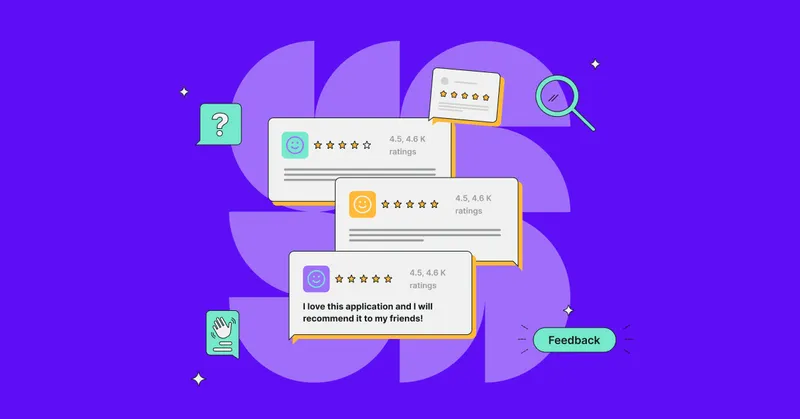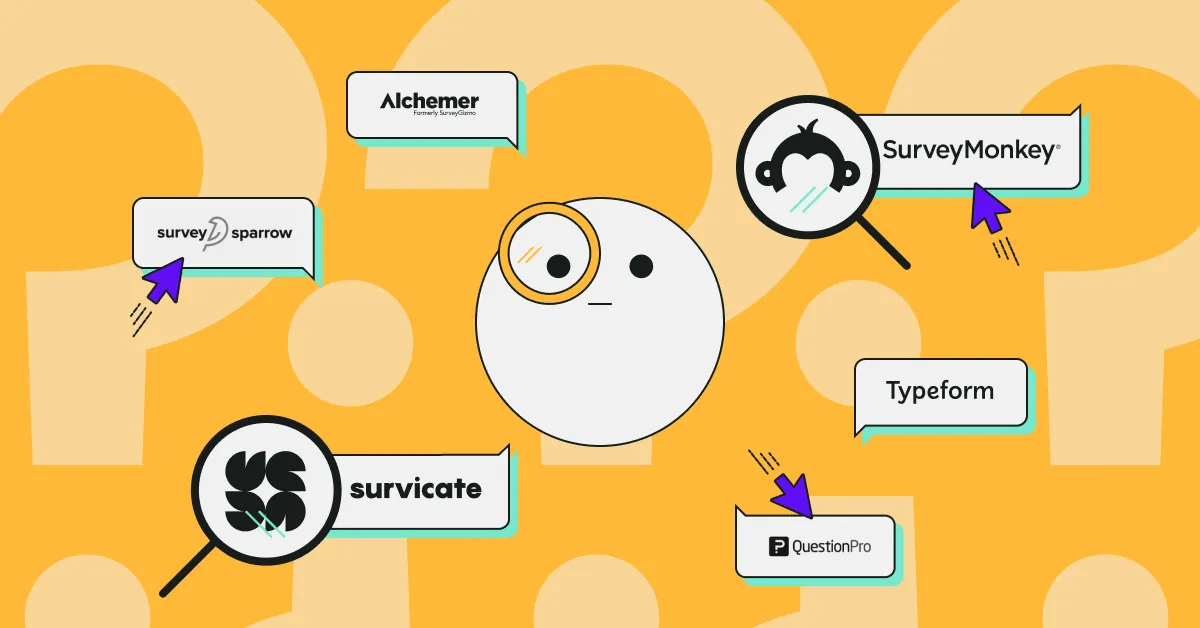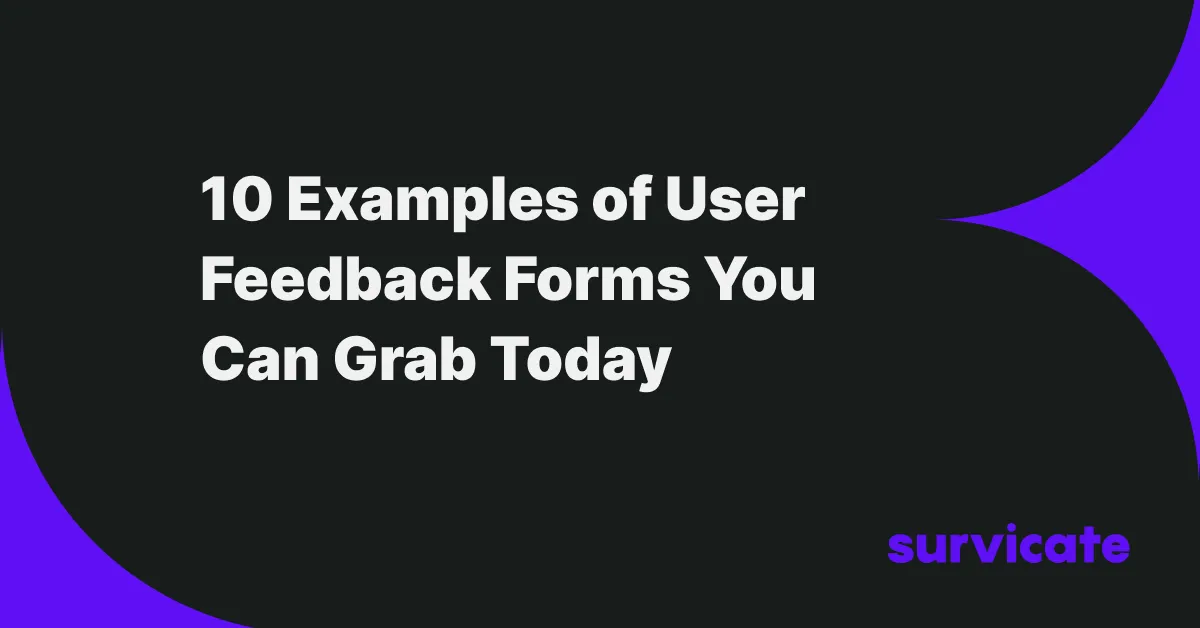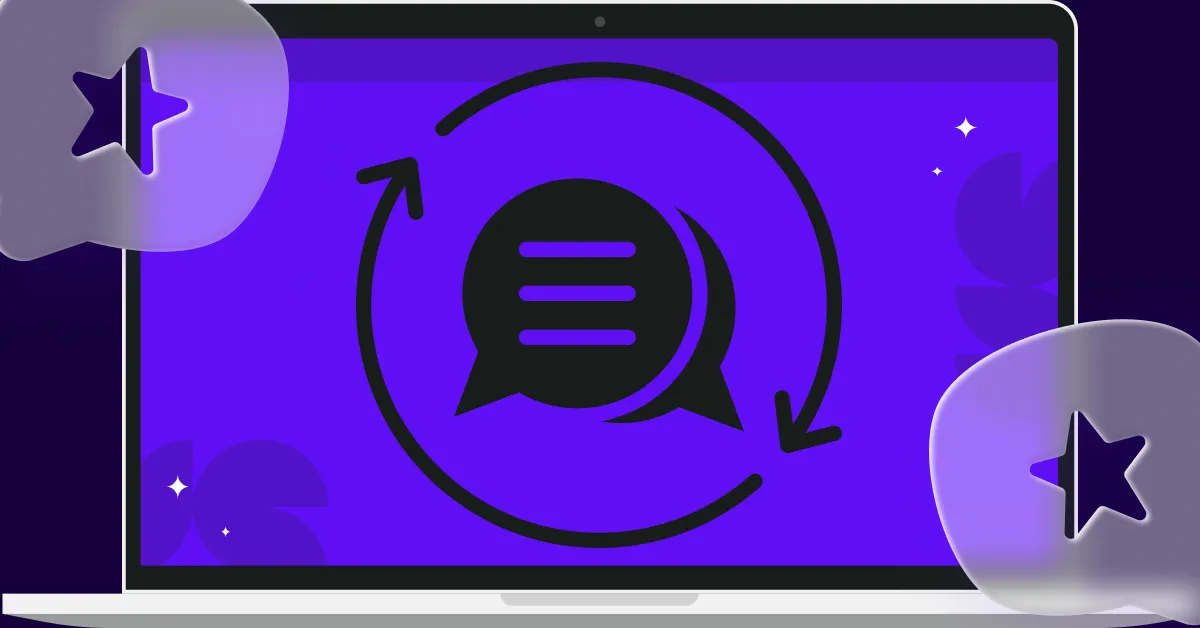If used properly, customer feedback is a powerful tool for improving a product or service. Companies benefit from user feedback because it helps them grow, develop products, build and maintain customer relationships, and better understand their target audience.
User feedback covers an array of types and methods, though.
“Getting user feedback” can mean a million things, but focusing on the right methods for your use case and business is important.
Today, we’ll guide you through the types of feedback and how you can put them in motion in your business.

Why Use Different User Feedback Types?
The answer is simple: not each type of user feedback will give you the answer you want.
If you’re looking for general feedback on a scale, you may use a different method such as an NPS survey, as opposed to collecting qualitative feedback. The methods will be different when you want to get as many insights as possible about a new feature released to a small group of beta testers. The examples can be multiplied.
Different types of feedback focus on different aspects of your product or service.
Thanks to various feedback types, you may know precisely what users like and need further development, or, for example, how satisfied they are doing online shopping at your store. You can get a lot of general info, or just a few yet extremely detailed comments – and both types of user feedback are priceless for your business.
If you mix and match user feedback types, you can get a crystal clear direction you should navigate your brand towards. This might not be possible if you stick to one, same, old survey.
Types of User Feedback
#1 Net Promoter Score (NPS)
What is NPS?
NPS stands for Net Promoter Score and you typically gather it via a survey with a single question. NPS measures how likely a user is to recommend a service or product to a friend, family member, or coworker.
Pros of NPS
There is only one short question increases the chances that people will leave feedback – it often takes only one click to answer. It’s easy to set up and implement with a tool like Survicate. It gives you a quick overview of customer satisfaction and potential business growth (high ratings may mean repeat business, which translates into higher sales and customer loyalty).
When to use NPS
- To measure customers’ willingness to recommend your business
- To get a quick grasp of how satisfied your customers are (e.g., whether users are happy with their trial period and want to upgrade)
- To give you insights into deeper user research or add new user feedback types to your strategy
How to use NPS
First, create an NPS survey in a tool such as Survicate - from scratch or a template. After you get the feedback, your answers immediately get categorized into:
- promoters - they responded with 9-10
- passives - they responded with 7-8
- detractors - they responded with 0-6
Promoters are likely to become your brand ambassadors, and passives see some room for improvement, but it’s detractors that impact your score and should bother you the most.
#2 Customer Satisfaction Score (CSAT)
What is CSAT?
It is short for Customer Satisfaction Score. The purpose of this feedback type is to measure customer satisfaction during specific interactions with the company, such as online payments or customer service interactions.
A customer gets a question and a numeric (but it also can be emojis, phrases, or single words) scale to choose their answer. The difference is that CSAT is about specific experiences, while NPS is a general impression.
Pros of CSAT
CSAT can be more measurable if you want to focus on getting user feedback on a particular part of your product or services. While it can help you identify unhappy customers per se, it will also bring your attention to happy customers with one-off negative experiences.
When to use CSAT
- To gauge customer satisfaction after a particular action or interaction with a product or service
- To get feedback on a specific part of your business
How to use CSAT
You should create a CSAT feedback survey that is simple, friendly, and welcoming. Embrace colors that align with your brand to create an integrated experience. You may also consider using color codes to shorten the choice for your customers:
How would you rate your experience with our customer support today?
Terrible | Poor | Neutral | Good | Great
#3 User Experience feedback (UX feedback)
What is UX feedback?
User Experience (UX) feedback is users' opinions on a product or service. This feedback can help designers, developers, or business owners improve the user experience for future products or services. Note that UX is different from customer experience.
Pros of UX feedback
You can get general or detailed feedback on the experience you deliver based on how you structure the survey. Thanks to UX feedback, you can see the pain points that customers themselves identify. In addition, this type of feedback might often be very detailed, so you get a lot of insight about your product, service, website, and whatever else your wish.
When to use UX feedback
- To make informed business decisions
- To set up the next steps for product development
- To evaluate if the previous changes passed the exam
How to use UX feedback
Create a set of questions that you could use to dig deeper into the "why" of the pain point you want to solve. Ask about specific parts instead of general experience – this will give you more accurate feedback you can implement step by step.
Instead of asking:
“How do you like our new website layout?”
Pose a question:
“Is the new search box feature intuitive for you?”
If someone gets the first question and answers it as “I hate it”, then you don’t quite know if they meant not liking it overall, despising a particular element of it, or something didn’t work for them and impacted their experience.
#4 Feature/product request
What is a feature/product request?
When someone requests a new feature for a product or asks for a change to an existing product - it is a feature/product request type of feedback.
Pros of a feature/product request
It can help companies improve their products and make them more user-friendly. Companies can also use it to determine which features they should develop next.
When to use a feature/product request?
Use this feedback type when you have doubts about which feature or product to develop first and put it on the product roadmap.
How to use a feature/product request?
Gather a feature/product request by embedding a short user feedback survey on your website and in newsletter messages that you send to your loyal customers and clients. Use a survey-building tool to find out what people think.
💡 Make sure your survey is mobile-friendly, so providing feedback is convenient for everybody, regardless of their device.
.avif)
#5 Goal Completion Rate (GCR)
What is GCR?
GCR stands for Goal Completion Rate. Using this metric, you can determine how successfully your users accomplish their goals on your website or mobile app. Besides, you can evaluate if your online presence works effectively to help your customers.
Pros of GCR
Goal Completion Rate is an important metric to track because it indicates how many of your visitors convert into customers. By understanding your GCR, you can better focus your efforts on improving the areas of your website that are not performing as well.
When to use GCR?
- When you need to monitor sales efforts
- To track how effective the visitors are in a specific area
- To see why people are visiting your website
How to use GCR?
You can simply ask your visitor, “Did you achieve your goal today” with yes/no answers. Also, you can put the additional question “Do you have any suggestions to make our website better?”, so they can leave the comments you may use for further improvements. Finally, ask what the reason for visiting your website was and whether website users achieved their goal.
To receive feedback, consider choosing a simple form. Pay attention to the tool you will be searching for - make sure it analyzes the results or integrates with tools you already use. Check out the list of integrations of Survicate.
#6 Willingness To Pay (WTP)
What is WTP?
Willingness To Pay (WTP) is a customer's maximum price they are willing to pay for a product or service. This metric helps optimize your prices to maximize your product or service sales.
Pros of WTP
One of the benefits of WTP is customer segmentation. It is relatively easy to measure. Also, you can make business decisions based on WTP in terms of pricing plans and products or service development.
When to use WTP?
- After finishing a free trial of the service
- When you want to determine price points
- When you want to develop your product or service
How to use WTP?
You can measure WTP in many ways. The best option is to send out surveys or polls via email, embed them on your website, or attach them to the newsletter.
💡 You don’t need to create a survey from scratch - see pricing survey templates to save time and money.
While measuring WTP, you can segment your customers and find similarities among the people willing to pay the most for your product or service. Also, you may deduce if you need more pricing plans - maybe some people are interested in your product but are willing to pay a lower price.
Willingness To Pay is not static, so it's worth monitoring this metric. Many factors influence WTP, such as the state of the economy, market trends, and customer location - just to name a few.
#7 Bug Feedback
What is Bug Feedback?
Bug feedback helps companies find and fix vulnerabilities in their software. Special accompanying bug bounty programs offer financial or non-monetary rewards to people who find and report security flaws.
Pros of Bug Feedback
No one likes getting negative feedback, but the sooner you get such insights, the sooner you can start acting on it.
Unlike other types of feedback, this type comes mainly from customers, without your prior encouragement or sending any surveys – and can help you not only fix but also improve your services.
This type of feedback also helps create a community of individuals interested in helping improve the security of online systems.
When to use Bug Bounty?
- When you develop a security program for an application
- After implementing a secure coding training program, creating a bug baseline, and using automated scanning for bugs
How to use Bug Bounty?
When setting up a bug bounty program, it's essential to make sure you are clear about what is and isn't allowed. You'll also need to create guidelines for researchers about how to report bugs. Finally, be prepared to pay out rewards when you get accurate reports.
#8 Customer Effort Score (CES)
What is CES?
CES means Customer Effort Score. It measures how much effort a user has to put in to interact with your company - you can do this with a CES survey. For example, to get their problem solved or make a purchase. The best interactions are low-effort ones - complicated interactions make customers less likely to be loyal.
A customer effort score helps you understand how customers feel about their interactions with the company.
Pros of CES
You can measure how difficult it was for a customer to complete a particular task. So it is a relatively detailed measurement. However, it can help identify areas where companies are making it difficult for customers to interact with them and then work on reducing the effort required.
When to use CES?
- After an interaction that resulted in paying for a subscription or purchasing
- After ordering the product
- After reaching out to the customer service
How to use CES?
The best way of collecting a Customer Effort Score is a simple survey ranging from “very easy” to “very difficult” or another variation that measures how difficult it was for the customer to accomplish a task.
#9 General feedback
What is general feedback?
You can collect general customer feedback in various places on the web and in person.
Pros of general feedback
There’re no limitations, meaning the scale or certain types of questions (which also have their benefits). Customers are free to describe the product as they want and describe their personal experiences.
When to use general feedback
- When you want to know general thoughts on your product or service
- After establishing new pricing plans
- After updating the product
How to use general feedback
If you want to encourage people to leave feedback, inform them they're contributing to something bigger - for instance, developing the product or improving it. Try to use a stronger CTA (call to action), then just “Let me know what you think”.
Also, make it easy for users to leave the suggestion - build a survey that can be adjustable and customizable to match your brand design. Survicate provides great templates of website feedback (and not only!).
It’s good to collect this type of feedback, leaving an open-question survey on the website or newsletter or emailing the customer with a couple of words of encouragement.
User feedback is a very powerful tool for businesses. Your customers’ opinions might show you room for improvement and increase customer experience.
Also, it is worth mentioning that feedback is great in the workplace. Therefore, providing constructive feedback might be a solid foundation for improving workflow and building relationships between employees.
Receiving feedback and giving it might be a tough nut to crack, especially at your workplace. However, giving constructive peer feedback might be a learning process and take time, so be patient and don’t give up.
In addition, being able to adjust to the situation and give informal feedback when necessary is also a skill. Informal feedback includes different vocabulary and differences in style. But the outcome should be the same - to improve.
💡 Giving constructive peer feedback might positively influence company culture.
Choose the user feedback the best for your business
Constructive feedback is critical while developing your business. So, don’t be afraid to implement different types of feedback as a development strategy element. It will help you to get an accurate understanding of how your customers and clients perceive your product or service.
It can also help you improve the quality and effectiveness of your offering.
Whether where you start or how big your company is, Survicate is a powerful tool for creating feedback surveys. Thanks to many templates, in-built analytics, and many integrations, receiving and giving feedback is a smooth process. Sign up for a 10-day free trial to make the most of the different types of user feedback! Also, you can foster your decision making checking our newst ranking of best customer satisfaction tools.
FAQs:
What is customer feedback?
Customer feedback is a customer's opinion about the product or service - buyers provide feedback after purchasing or using a service. Customer feedback is essential to businesses because it provides them with information about what their customers like and don't like about their products or services.
What are the types of customer feedback?
There are many types of customer feedback. The most powerful ones are NPS, CSAT, UX feedback, feature/product request, GCR, WTP, Bug Bounty, CES, and general. Each provides different information and evaluation of various aspects of your product or service.
How many types of feedback can a user provide?
Quite a few of them. Regardless of the type of feedback you ask for, a user can provide positive feedback, informal feedback, formal feedback, peer feedback, coaching feedback, upward feedback, employee evaluation feedback, actionable feedback, and more.
What are the two primary types of customer feedback?
There are two main categories of customer feedback: positive and negative. Positive feedback is when a customer compliments a business on its product or service, while negative feedback is when a customer complains about a product or service. Both can be delivered via survey, for example, likert scale survey.
What’s the difference between feedback and feedforward?
Feedback is a response to something already said or done. It is a comment on users’ experience with the product. Feedforward is a message that provides information or suggestions for the future. A positive feedforward may help prevent problems and ensure that users can see all of the necessary information.
💡 YOU MAY ALSO BE INTERESTED IN:











.png)



.svg)

.svg)



